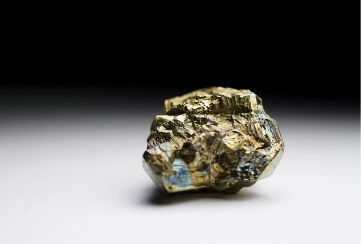
“All that glitters is not gold” is an age-old aphorism usually used to warn people about the deceptive appearance of things and people. However, it is also quite true since many minerals resemble gold in appearance; however, they do not have all its important characteristics. A mineral called pyrite has been the center of fascination for many geologists since it looks exactly like gold, earning it the name fool’s gold.
The shimmering golden appearance of pyrite has often led people to mistake it for genuine gold, only to be disappointed when they try to sell gold online or otherwise. This article will delve into the fascinating world of fool’s gold, exploring its characteristics, formation, and uses.
The Characteristics of Fool’s Gold
Pyrite is a naturally-occurring mineral that is quite abundant in nature. It has many characteristics that earn its comparison with gold. Here are the major characteristics of pyrite:
1. Shiny Golden Appearance
Fool’s gold, scientifically known as pyrite, exhibits a brilliant metallic luster that can be easily mistaken for gold by the untrained eye. It often appears as golden flakes, cubic crystals, or a massive aggregate of tiny crystals. Pyrite’s distinct color and shine contribute to its nickname as fool’s gold, as it mimics the appearance of the precious metal.
2. Chemical Composition
Pyrite’s similarities with gold are only limited to appearance since it has a completely different chemical composition than gold. Gold is an element represented on the periodic table as Au, while pyrite is an iron sulfide mineral. The presence of iron and sulfur gives pyrite its distinctive properties and sets it apart from its valuable counterpart.
Origin and Formation of Fool’s Gold
Like other minerals, pyrite forms due to millions of years of geological processes in certain environments. The formation of pyrite involves complex geological processes, including the reaction of iron and sulfur under specific conditions. It commonly occurs alongside other minerals such as quartz, calcite, and other sulfides.
Pyrite can be found worldwide, occurring in a variety of geological settings. It often occurs associated with mineral deposits and can be abundant in areas rich in sulfide minerals. The presence of pyrite in rocks and soils can have significant implications for various industries, including mining and exploration.
Common Misconceptions about Fool’s Gold
Due to its close connections to gold, there are many misconceptions that surround pyrite. Here are a few of the misconceptions about fool’s gold debunked:
1. Pyrite has The Same Value as Gold
One of the most widespread misconceptions about fool’s gold is that it holds a monetary value similar to gold. While pyrite may have industrial uses, it lacks the rarity and intrinsic value that gold possesses. Its economic significance lies mainly in its use as a source of sulfur in the production of sulfuric acid and as an ore of iron.
2. It is Very Hard to Differentiate it from Gold
While pyrite and gold do look alike to the untrained eye, there are plenty of ways to differentiate between the two metals. Gold has a distinct yellow color, whereas fool’s gold often has a more brassy or pale golden hue. One effective technique is performing a hardness test. Since pyrite is harder than gold and does not possess the same softness that gold has. Another method involves examining the crystal structure, as pyrite often forms cubic crystals, unlike the more rounded shapes of gold.
3. Pyrite Has The Same Uses as Gold
Despite their similar appearances, pyrite cannot be used for the same purposes as gold since they have majorly different physical characteristics. Gold can be easily converted into gold jewelry since it is easily malleable and can flatten when hit by a hammer. Pyrite, on the hand, is much harder and can shatter when given the same treatment as gold. Therefore, using pyrite in the same ways as gold is difficult and cannot be easily molded into coins, jewelry, or bars.
4. Fool’s Gold has no Practical Uses
Contrary to popular belief, Fool’s Gold has practical uses beyond its visual appeal. As mentioned earlier, pyrite is utilized in the production of sulfuric acid, which is crucial for various industrial processes. It also creates sparks, making it valuable for firearms and fire-starting devices. These applications demonstrate that fool’s gold does have practical value despite not possessing the same allure as gold.
Fool’s Gold as a Cautionary Tale
Fool’s gold has long been associated with myths and legends. In ancient times, it was often mistaken for gold, leading to tales of deception and disappointment. These stories served as cautionary tales, reminding people to be wary of false promises and appearances. In classic literature such as Treasure Island and Huckleberry Finn, Fool’s Gold represents the dangers of greed and the importance of using your rationality instead of being overpowered by your desires.
Final Thoughts
Fool’s Gold, or pyrite, with its shimmering golden appearance, has fascinated and deceived people throughout history. Despite its striking resemblance to genuine gold, pyrite is a mineral with its distinct characteristics and uses. Understanding the differences between fool’s gold and gold is crucial for avoiding disappointment when you sell your gold jewelry.
Fool’s gold has captured the human imagination, appearing in myths, literature, and popular culture as a cautionary symbol. If you also do not want to be part of a cautionary tale, it is best to get your gold assets appraised before you sell your gold. Gold to Cash is the best place to sell gold online since our services also include a free appraisal. All you need to do is send in your jewelry via the company’s free appraisal kits, and we will provide you with an estimate for your assets.
Contact us now to learn more about online gold buyers and how to avoid the follies of fool’s gold by converting your gold to cash.